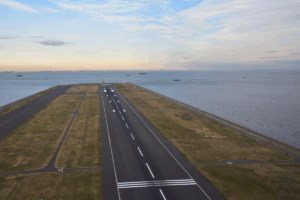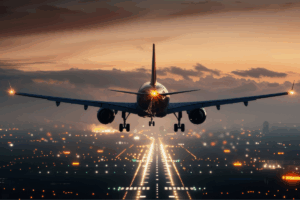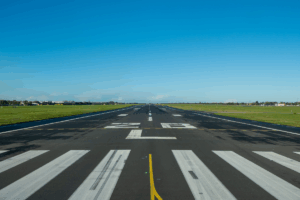As we turn the calendar on another year, we thought we’d look ahead at the trends our experts expect to see in 2025 as airports make swift investments in their airport runway systems to improve safety, efficiency, sustainability, and cost-effectiveness.
Continued Transition Toward LED Technology
LED technology continues to revolutionize the airport lighting industry – and for good reasons:
- LED lamps typically provide between 50,000 to 100,000 hours of service (and sometimes more), lasting approximately 25 times longer than incandescent, fluorescent, and HID bulbs, thus requiring fewer replacements over their lifetime
- They offer increased durability, being able to withstand shocks, extreme temperature changes, and moisture better than traditional bulbs
- LEDs use energy more efficiently than other types of lamps, significantly lower energy costs
- The technology provides improved visibility at night and during low-visibility conditions, giving pilots and controllers better distance perception during these times
- These systems can integrate seamlessly with other safety-enhancing runway lighting, power, and control technology, such as smart systems, automated adaptive controls, and IoT that give airport operators a wealth of data that supports strategic decision-making
In 2025, we expect airports worldwide to continue upgrading their runway lighting systems to LEDs to capitalize on these advantages.
Increased Adoption Of Sustainable Practices
Increasing awareness of environmental sustainability and cost-effectiveness propels the demand for energy-efficient lighting solutions. Runway lighting manufacturers are innovating to develop products that reduce energy consumption while maintaining optimal performance.
For example, Precision Approach Path Indicators (PAPI) assist pilots during approach and landing by helping them maintain the correct glide path and make more precise landings, even in poor weather conditions. As a result, planes consume less fuel and reduce emissions associated with aborted landings and loop-arounds.
Additionally, airport lighting control and monitoring systems (ALCMS) utilize sensors, weather data, and real-time information to optimize lighting conditions by dynamically adjusting lighting intensity and color, which reduces unnecessary light output during clear nights or when there is no flight activity. This technology assists in minimizing light pollution and energy waste, helping airports reduce their carbon footprint.
As “Dark Sky” initiatives continue to grow in 2025, airport operators will increasingly look at ways to reduce unnecessary lighting, such as establishing nighttime lighting curfews and wildlife-friendly lighting practices.
Read More: Innovations In Bird Control Measures At Airports
AI Will Make More Inroads Into Airport Lighting Systems
Artificial intelligence (AI) technologies are making their way into our everyday lives, helping us manage basic tasks. They’re also being integrated into many industrial sectors, including airport lighting systems.
AI can be applied to help enhance the efficiency of airport operations with little human intervention. For example, AI systems can collect data on different types of aircraft that use a particular airport and automatically optimize the approach lighting system based on that intelligence. These adjustments include adjusting the brightness or spacing of the lights to ensure a safe approach and landing, which is especially beneficial to pilots of larger aircraft, which require more lighting.
These intelligent systems can also analyze data from the aircraft’s sensor, such as the airplane’s speed, position, and altitude, and provide real-time feedback to pilots so they can make the necessary adjustments to land safely.
Increased Public And Private Investments In Airport Infrastructure
In 2025, we expect a surge in global air travel, resulting in increased passenger and cargo traffic that necessitates enhanced safety measures. This increase may also mean more nighttime flights to accommodate the increase in air traffic and larger aircraft, fueling the need for expanded and advanced runway lighting systems.
As a result, airports will need to make substantial investments in their airport infrastructure, including runway traffic management systems. Financial commitments from both the public and private sectors will be key in supporting the modernization of airports to meet the growing demand.
Increased Competition Between Suppliers
As airport operators invest more in expanded and upgraded airport lighting systems, suppliers will be competing heavily for contracts to increase their market share. Successful suppliers will be the ones delivering solutions that focus on their customers’ needs, including increased energy efficiency, enhanced safety measures, and compliance with relevant governing bodies.
Additionally, as operators grow more comfortable with the idea of advanced technology, runway lighting suppliers will have an opportunity to introduce them to the benefits of smart and automated runway lighting systems.
Airport lighting suppliers must also focus on creating value for their customers through collaboration, focusing on integrated systems, partnerships, and after-sales technical support to stand out in this tightening market.
Call Airport Lighting Company For The Latest In Airport Lighting Technology
The Airport Lighting Company team is standing by to answer your questions about how our products can help your airport meet its sustainability objectives and improve the safety and reliability of your operation. Call 315-682-6460 for fast, friendly service you can count on.


